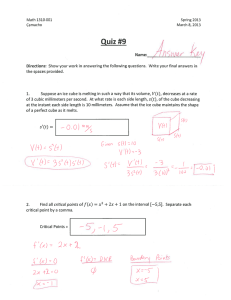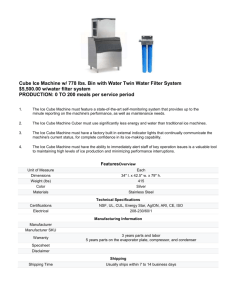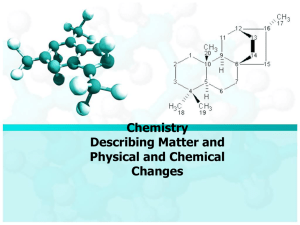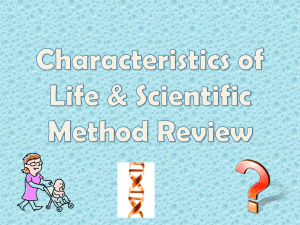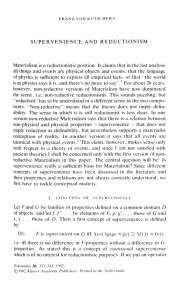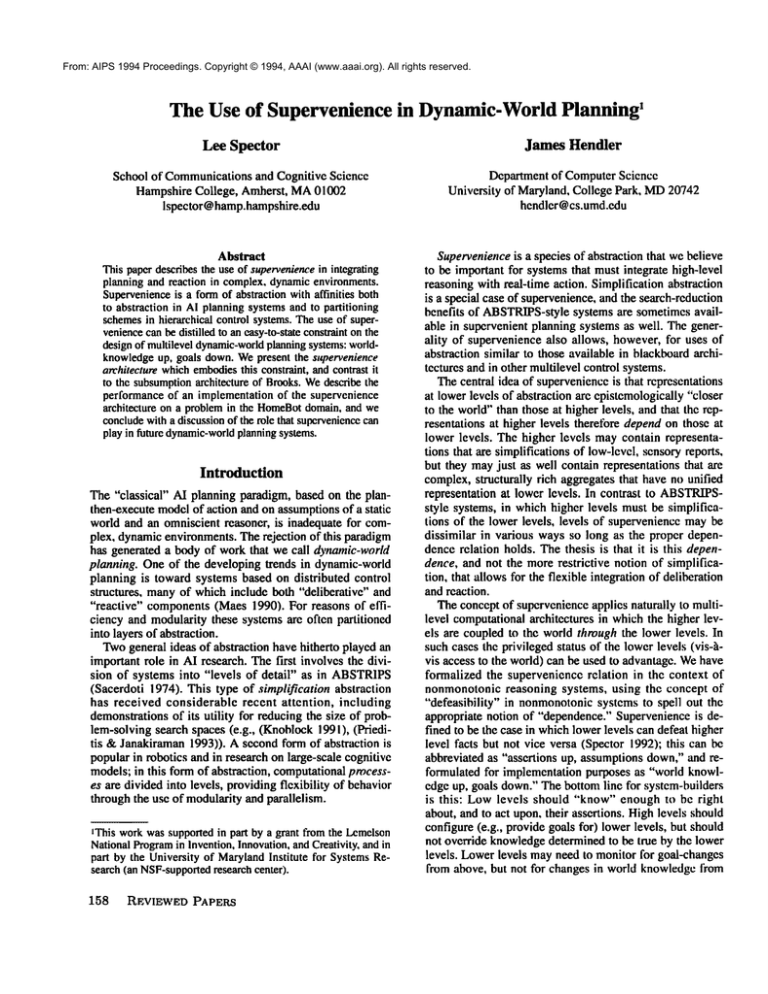
From: AIPS 1994 Proceedings. Copyright © 1994, AAAI (www.aaai.org). All rights reserved.
The Use of Supervenience in Dynamic-World
Planning’
Lee Specter
James Hendler
School of Communicationsand Cognitive Science
Hampshire College, Amherst, MA01002
Ispector@ hamp.hampshire.edu
Department of ComputerScience
University of Maryland, College Park, MD20742
hendler@cs.umd.edu
Abstract
Thispaperdescribesthe use of supervenience
in integrating
planningand reaction in complex,dynamicenvironments.
Supervenience
is a formof abstractionwithaffinities both
to abstraction in AI planningsystemsand to partitioning
schemesin hierarchical control systems.Theuse of supervenieneecanbe distilled to an easy-to-stateconstrainton the
designof multileveldynamic-world
p "lanningsystems:worldknowledgeup, goals down.Wepresent the supervenience
architecturewhichembodies
this constraint, and contrast it
to thc subsumption
architecture of Brooks.Wedescribe the
performanceof an implementationof the supervcnience
architecture on a problemin the HomeBot
domain,and we
concludewitha discussionof the role that supcrvenience
can
play in future dynamic-world
planningsystems.
Introduction
The "classical" AI planning paradigm, based on the planthen-execute modelof action and on assumptionsof a static
world and an omniscient reasoner, is inadequate for complex, dynamicenvironments.The rejection of this paradigm
has generated a body of work that we call dynamic-world
planning. One of the developing trends in dynamic-world
planning is toward systems based on distributed control
structures, manyof which include both "deliberative" and
"reactive" components(Maes 1990). For reasons of efficiency and modularity these systems are often partitioned
into layers of abstraction.
Twogeneral ideas of abstraction have hitherto played an
important role in AI research. The first involves the division of systems into "levels of detail" as in ABSTRIPS
(Sacerdoti 1974). This type of simplification abstraction
has received considerable recent attention, including
demonstrationsof its utility for reducing the size of problem-solving search spaces (e.g., (Knoblock1991), (Prieditis & Janakiraman1993)). A second form of abstraction
popular in robotics and in research on large-scale cognitive
models; in this form of abstraction, computationalprocesses are divided into levels, providing flexibility of behavior
through the use of modularityand parallelism.
1This workwas supportedin part by a grant from the Lemelson
NationalProgram
in Invention,Innovation,and Creativity, andin
part by the University of MarylandInstitute for SystemsResearch (an NSF-supported
research center).
158
REVIEWED PAPERS
Supervenienceis a species of abstraction that wc believe
to be important for systems that must integrate high-level
reasoning with real-time action. Simplification abstraction
is a special case of supervenience,and the search-reduction
benefits of ABSTRIPS-stylesystems are sometimesavailable in supcrvenient planning systems as well. The generality of supervenience also allows, however, for uses of
abstraction similar to those available in blackboard architectures and in other multilevel control systems.
The central idea of supervenienceis that representations
at lower levels of abstraction are epistemologically"closer
to the world"than those at higher levels, and that the representations at higher levels therefore dependon those at
lower levels. The higher levels maycontain representations that axe simplifications of low-level, sensory reports,
but they mayjust as well contain representations that axe
complex,structurally rich aggregates that have no unified
representation at lower levels. In contrast to ABSTRIPSstyle systems, in which higher levels must be simplifications of the lower levels, levels of supervenience maybe
dissimilar in various ways so long as the proper dependence relation holds. The thesis is that it is this dependence, and not the more restrictive notion of simplification, that allows for the flexible integration of deliberation
and reaction.
The concept of supervenienccapplies naturally to multilevel computationalarchitectures in which the higher levels are coupled to the world through the lower levels. In
such cases the privileged status of the lower levels (vis-avis access to the world) can be used to advantage. Wehave
formalized the superveniencc relation in the context of
nonmonotonic reasoning systems, using the concept of
"defeasibility" in nonmonotonicsystems to spell out the
appropriate notion of "dependence." Supervenienceis defined to be the case in whichlower levels can defeat higher
level facts but not vice versa (Specter 1992); this can
abbreviated as "assertions up, assumptions down,"and reformulated for implementation purposes as "world knowledge up, goals down."The bottom line for system-builders
is this: Lowlevels should "know" enough to be right
about, and to act upon, their assertions. Highlevels should
configure (e.g., provide goals for) lowerlevels, but should
not override knowledgedetermined to be true by the lower
levels. Lowerlevels mayneed to monitor for goal-changes
from above, but not for changes in world knowledgefrom
From: AIPS 1994 Proceedings. Copyright © 1994, AAAI (www.aaai.org). All rights reserved.
above. Inter-level communicationprocedures can take advantage of this restriction. The knowledge/action "domains"of each level should be chosen with this restriction
in mind.
The history of supervenience and its relation to other
formsof abstraction in the literature can be found in (Spectot 1992). A discussion that relates this work to the neuropsychology of humanplanning can be found in (Spector
&C-rafman,in press).
The Ice Cube Problem
Consider a householdrobot in the midst of a routine chore.
Supposethat an ice cube is on the floor in the middleof a
room, and that at somepoint it is seen by the robot. Any
assumption of a built-in "ice cube reaction rule" is problematic, ice cubes do not always present problems, and any
reaction rule that checks all contextual circumstances to
determine if there is a problem upon each sighting of an
ice cube would be computationally complex if constructible at all. Weshould therefore assumethat no such
rule exists, and hence we should expect no immediate response to the sighting of the cube. Assumingthat the robot
has sufficient causal knowledgeto infer that the ice cube
will melt over time, however,and assumingthat it can also
infer that puddles maybe dangerous, it wouldbe appropriate for the robot to eventually makesuch inferences, and to
alter its behavior accordingly.2 The robot should then suspend work on its current task, take care of the potential
safety hazard, and then resumethe original task with as little replanningas possible.
Neither "replanning" systems nor "purely reactive" systems are capable of producing appropriate behavior in this
problem. Replanningsystems are driven by failures, but in
the Ice Cubeproblem no failure occurs. The change in behavior after seeing the ice cube mustbe triggered by inferences, not by simple conditions that maybe detected in the
world. Purely reactive systems preclude, by definition, the
use of reasoning processes that could infer the necessary
3causal connections at runtime.
Problems like the Ice Cube problem make it clear that
reasoning and reaction must be integrated, and not just
combined, in systems that are to produce appropriate behavior in complex, dynamic environments. Approaches to
such integration generally involve concurrency, and often
divide computational componentsinto "levels" in order to
organize the complexsystems that result (Gat 1991). The
notions of "level" that have been used in this context form
a large and heterogeneousset; one of the goals of our research is to articulate principles that underlie goodchoices
of levels, and good strategies for inter-level communication, for systemsthat integrate reasoningand action.
2Of course, the ice cube maybe hazardousbefore it melts as
well; in any event we maypresumethat reasoningis required to
infer the existenceof a presentor futurehazard.
-~Examples
of systemsthat weconsiderto be "purelyreactive" are
those described in (Agre &Chapman
1987)and (Schoppers1987).
TheSupervenienceArchitecture
The supervenience architecture specifies that a numberof
data/processing levels be arranged in a partial order, with
the minimalelements of the partial order connected to sensors and effectors. The levels mayrun in parallel and communicate asynchronously. Each level should contain both
procedural and declarative components, and should model
the world, solve problems,and initiate actions at a particular level of abstraction. Translation systems, situated between planning levels, are to pass goals downwardand information about the state of the world upward. This
implements the asymmetric supervenience relation between levels----~e dependence of high-level knowledge
upon low-level knowledge.
Although the procedures at each level should possess
certain general properties (such as interruptability at some
level of temporal granularity) the architecture allows for
the use of radically different planning methodologiesat
each level. For example, one might use a connectionist
system at the lowest level, logic programmingtechniques
at intermediate levels, and a planning system such as
NONLIN
at the highest levels.
Comparison
to the Subsumption
Architecture
The subsumption architecture of Brooks is a well known
architecture for mobilerobots (Brooks 1990). Brookscharacterizes previous systems as decomposing behavioral
problemsinto a series of "functional units" that can be illustrated by a series of "vertical slices." He prefers a decompositioninto "task achieving behaviors," illustrated by
a series of "horizontal slices." The superveniencearchitecture combines these two methodsof decomposition (as do
others, e.g. (Albus 1991)). The superveniencearchitecture
allows, as does the subsumptionarchitecture, the direct
coupling of sensation to action at the lowest level of the
system. The lowest levels can provide basic "competencies" without the intervention of higher, morecomplexlevels. Onthe other hand, the superveniencearchitecture stipulates that the higher levels receive their knowledgeof the
worldvia the lower levels of the system, and that they pass
commands
for action (expressed as goals) through the lower levels as well. This accords with someof the principles
of "vertically sliced" systems; for example,that the knowledge required for planning is provided via modelingfrom
perception, and not from the sensors directly. The resulting
mix of horizontal and vertical decompositionis quite practical-indeed, someexamples of the subsumption architectare exhibit such a combination(Brooks 1990, 15-19).
In the subsumptionarchitecture, the "reasoning" at each
level is performedby a set of modulesimplementedas augmentedfinite state machines. The finite state machinesare
"hard wired"--they are created whenthe system is built and
are never changed. The topology of the modulenetwork is
also static. Regardless of the theoretical computational
powerof such systems, it is not at all clear howone would
encode complex symbolic AI systems within these finite
state machines--indeed, Brooks is interested in showing
SPECTOR
159
From: AIPS 1994 Proceedings. Copyright © 1994, AAAI (www.aaai.org). All rights reserved.
howinteresting behavior can emerge from the simplest of
systems. The superveniencearchitecture, in contrast, allows
for arbitrary processesat each level.
Bottom-up communicationin the subsumption architecture is simply a matter of connecting the appropriate
"wires" so that low-level data flows to high-level modules.
Bottom-up communicationin the supervenience architecture is similar, but a significant difference appears with
respect to top-down communication. In the subsumption
architecture, top-down communicationoccurs by "inhibition" of the outputs of low-level modules, and by the "suppression" and "replacement" of the inputs to low-level
modules. In the case of inhibition, high-level modulessimply cancel the effects of low-level modulesthat continue to
run. In the case of suppression/replacement, higher-level
modulesreplace the inputs of lower-level modules, thereby altering their behavior.
The use of suppression/replacement
for knowledge
about the world is entirely inconsistent with the principles
of the superveniencearchitecture. In the superveniencearchitecture lower levels are epistemologically "closer to the
world"--their knowledge cannot be defeated by knowledge from higher levels. Higher levels in the supervenience architecture communicatewith lower levels via
goals--they configure the behavior of the lower levels, but
they do not override lower-level knowledgeof the world.
Theuse of action inhibition is also inconsistent with the
principles of the supervenience architecture. Lower-level
procedures, on the basis of goals (perhaps obtained from
higher levels) and knowledgeof the world, compute and
execute actions to achieve goals; they are presumedto have
the necessaryknowledgeto achieve their goals at their level. The higher levels mayprovide goals, but the determination of appropriate lower-level actions to achieve such goals
is the prerogativeof the lower, not the higher, level.
It is possible to restrict the top-downcommunication
in
a subsumptionsystem to conformwith the principles of the
supervenience architecture: the use of inhibition can be
avoided, and inputs can be grouped as "goal" and "world"
inputs, with suppression/replacement allowed only for the
former. Suchrestrictions are not, however,part of the subsumptionarchitecture philosophy.
Alternative architectures can be found in the literature,
someof which use communicationstrategies that are more
like supervenience than they are like subsumption(e.g.,
TCA(Lin, Simmons & Fedor 1989) and ATLANTIS(Gat
1991)). Webelieve that systems built on these architectures will scale up better than will subsumptionsystems,
and that strict adherence to the supervenience constraint
mayprovide further advantages.
Implementation
The Abstraction Partitioned Evaluator (APE)is an implemented dynamic-worldplanning shell based on the supervenience architecture. Here we list APE’sspecific levels
and provide a brief discussion of the types of knowledge
represented at each level; a more complete discussion can
be found in (Spector 1992).
160
RRWEWBDPAPERS
The levels used in APEare, from lowest to highest: perceptual/manual, spatial, temporal, causal, and conventional
(see Figure 1). A linear order is imposedon the levels, although the supervenience architecture allows any partial
order. The italicized annotations to Figure 1 are characteristic of the types of knowledgeat each level: they show
howa particular sighting of a smokecloud might be cognized across the hierarchy.
The perceptual/manuallevel represents events as sensory reports and as operators for effector manipulation. The
coupling of perception to action at this level is analogous
to simple "reflex arcs" in animals. Althoughspatial and
temporal data is present at this level, reasoning about
space and time occurs elsewhere. The spatial level contains
structures that organize perceptual data with respect to spatial relations such as on, above, near etc., along with operators for spatial reasoning (e.g., path planning). The temporal level augmentsspatial representations with temporal
relations, allowing for reasoning about deadlines and temporal projection. Whileevery level represents time in some
manner(and certainly every level acts in time), only at the
temporal level do representations such as "Betty is late"
arise: lower levels simply tag representations with temporal information and performactions as quickly as they can.
It is at the temporal level that the system reasons about
time and schedules actions to meet deadlines. The causal
level contains representations that embodythe agent’s conccption of the causal structure of the world, including
causal rules and causally deducedfacts. The conventional
level contains knowledgeabout facts that are true only by
convention: for example, that a certain hand gesture is a
signal for a turn, that a dirty sock "belongs"in the hamper,
or that a certain condition is consideredundesirableor dangerous.
APE’slevels partition the system’s knowledgeinto a set
of connected, communicatingsystems, each of which exhibits limited expertise at a particular level of abstraction
from the world. Note that this is not to say that the representations characteristic of one level are entirely absent
from all other levels. For example, temporal representations exist at all levels of the system, eventhoughexplicit
reasoningabout time occurs only at the temporal level.
The planning procedures in APEare implementedas operators that are instantiated in a goal-driven fashion. APE
Conventional
probable humandanger
probablefire in kitchen
smokecloud growing
smokein kitchen doorway
[ Perceptual/Manualsmoke@x,y,z,t=...
FigureI. Thespecific levels of APE.
From: AIPS 1994 Proceedings. Copyright © 1994, AAAI (www.aaai.org). All rights reserved.
li I I li
Eam-Pmim
II H I I I I
Flnd-lmpfop~o~
Find-Hazard
III II t~Jl
Spon~e-Trlck
operators contain specifications for asynchronousparallel
action networks, similar to Petri nets (Peterson 1981), that
are incrementally expandedand executed. All parallelism
in APEis currently simulated. Operator instances have priorities that can be passed through goals; if a goal is posted
witha certain priority then that priority is inherited by operators triggered by the goal. Thesepriorities are used by resource arbitrators to handle resource conflicts amongstoperator instances. The between-level translation systems are
implementedas collections of rule-based structures that run
continuously, posting goals to lower levels on the basis of
existing higher level goals, and manipulating lower level
data to producehigher level knowledge.Additional features
of the implementationare documentedin (Spector 1992).
HomeBot and the Ice Cube
HomeBotis a simulated robot that "lives" in a one bedroom apartment. HomeBotis expected to perform household tasks such as cleaning and protecting the humanresidents from danger. Exogenousevents may be triggered at
any time, and HomeBot"knows"only that which it can infer from the data (descriptions of pre-recognized objects)
that it receives throughits sensors.
The HomeBotdomain presents challenges for dynamicworld planning research because of the structural richness
of the real-world events that can occur. While regimented
domainssuch as Tileworld (Pollack & Ringuette 1990) are
useful for certain quantitative studies, they do not give rise
to high-level symbolic reasoning tasks with which realworld agents must contend. The Seaworld domainof (Vere
& Bickmore1990) and the Delivery Truck Domainof (Firby 1989) are both similar to the HomeBotdomain in that
realistic segmentsof the world are simulated to a level of
detail intermediate betweenthat of the real world and that
of "toy" domains such as the Blocks World. A discussion
of design issues for related test-bed environmentscan he
found in (Hanks, Pollack & Cohen1993).
The Ice Cube problem provides an example of the need
for integration of reactive and deliberative components
within dynamic-world planning systems. Recall that the
appropriate behavior in the early stages of the Ice Cube
problem is for HomeBotto continue the previous chore
while reasoning about the ice cube. Oncea hazard is inferred the previous chore should be suspended, and the
hazard should be removed. After the hazard is removed
work should resumeon the previous chore with as little replanning as possible.
In our implementationhigh-level operators perform sufficient initial reasoningto set up monitorsfor "interesting"
conditions with respect to their levels of expertise; for example, the conventional-level earn-praise operator monitors for "improper" or "hazardous" conditions. Wheneither is founda goal is posted for its abolishment.Goalsfor
the removal of improprieties are given normal priority,
while goals for the removal of hazards are given urgent
priority. This prioritization is a simple piece of conventional knowledgeencoded into the eam-pm|uoperator.
Normal chore-oriented behavior is generated by sub-
i
II II 1 I II I I I II
II
U II It l
I1 I I
q II II
il II
Ill!
I
~ I
Do-U.~.
Project
III t’i~ I I II I I II II
Achleve-ARer
Check-Tlme-Slnce-Felt
I l I II I
I I II Ill
Check-Time-Since-LookedI I I I 11 i
II
Maintoin-Body-Awamness
I I I
I I
Comp
uto-l-lelg~-Relalons
Compute-Stacking-Rela6ons
Check-For.Clesr-Pat~
Plsn-Pa~
III
gl II
II I
II I
Get-Rid-Of-Object
Get-W’~in-Reach
Figure-Direction
Rotate
Roll
Roll-On-Path
Hand-Pain-Reflex
Pain-Reflex
Close-Hand
I
Open-Hand
Re~"t-Ann
IIII
Extend-Am1
Lower-Arm
I
Raise-Arm
Turn-Counter-Clockwise
Tum-Clockwise
IIIIIIII
I I
I I
I
I
(’rllII II II HI BIIlibII II I11
II II Jill
%11
II
_
Put-On
Move-Obiect
Grab
Move-Hand
III
~111 II II
III Hi
I
II
- I
~rllii i
II
iii IIHI IIHIII III 511
(~
i
Move-Backward
Move-Forward
Feel
¯ ook
u II
(I)
Tkne
I III
(~jIII
alll
Igll IIII
II
II
II
II
D.
II
II
I
II
Figure2. Operator
activationsfor part of theIce Cube
problem.
goaling to discover and abolish improper conditions. In the
run described here, the improper condition is a dirty sock
on the floor. A representation of the sock propagatesto the
causal level, where the do-laundry operator generates a
plan to clean the sock via a series of goals that will decompose into temporal, spatial, and perceptuaFmanual
tasks.
Figure 2 shows an operator activation graph for a segment of the run. The activity of operators is indicated by
short vertical lines; time is represented by the horizontal
axis. Eachvertical line indicates an explicit allocation of
CPUtime to an operator instance, but operator instances
may be "working" via the activity of demons even when
no activations are shown.The double horizontal lines separate levels; from top to bottomthese are the conventional,
causal, temporal, spatial, and perceptual/manual levels.
The initial (left) portion of the graph showsHomeBotsimultaneously picking up the sock and noticing the ice
cube. The large square indicates the actions of picking up
the sock (extending the arm, closing the hand, and then
raising and retracting the arm), while the circles showthe
flow of activity relating to the ice cube. The left-most,
lower-most circle indicates the look operation during
which the ice cube is first seen. The subsequent circles
showthe propagation of the representation of the ice cube
to the causal level, at which a state change (melting)
projected, and to the conventional level, at which the
SPECTOR
161
From: AIPS 1994 Proceedings. Copyright © 1994, AAAI (www.aaai.org). All rights reserved.
change is recognized as a hazard. The sponge-trick operator contains a remedyfor ice cube hazards: put a spongeon
the cube to absorb the water as the ice melts. Althoughthis
solution is contrived it is not "hard wired"---oncethe goal
of preventingthe puddle is posted, morerealistic operators
could also be employed to discover a solution. The mow
important point, however,is that the solution is not hard
wired to the conditions in the world. The fact that spongetrick is applicable requires inference of the hazard, and the
inference processes progress in parallel with action.
The later (right) portion of the graph showsthe decomposition and execution of the plan for movingthe sponge.
The circles indicate the major events in this process, while
the tall rectangle indicates the suspension of the previous
task. Note that work on the previous task continues until
the hazard-prevention task is decomposedto the point at
whicha resource conflict occurs. (The roll and get-rid-ofobject operators both use the arm-control resource.) Once
the operator instances for the newtask have seized control
of the robot’s arm, the sock is dropped(via get-rid-of-ob.
ject, lower-arm,and open-hand)and actions arc initiated
for the tasks of retrieving and movingthe sponge. By the
end of Figure 2 a new instance of the roll operator has begun to execute.
Further graphs (see (Spector 1992)) showthe eventual
completion of the hazard-prevention task and the resumption of the laundry task. Whenthe sponge is dropped the
hand-control resource is released, allowing for the resumption of operator instances that had previously been
suspended. The instance of the move~b]ectoperator that
was involved in movingthe sock failed during the hazardprevention task: it had posted a demonto monitor ’(holding dirty-sock) that fired, triggering failure, shortly after
the sock was dropped. The operators working on subgoals
of move-obl~’t(for example, roll) were also terminated
that time. The goal of movingthe sock remained, however,
ar, d a newinstance of mova--oblectwas instantiated, leading also to an instance of grab. This instance of grab was
suspended as soon as it requested the arm-control resource. Whenthe sponge is dropped and the arm-contro!
resource once again becomes available, the suspended
grab operator is resumed. The resumption of the laundry
task is fairly simple becausethe intervention of the hazardprevention task caused failures only at the lowest level;
none of the componentsof the laundry task at other levels
of representation were affected. This localization of the
failure to the lowest level derives from our choice of levels, which in turn derives from the concept of supervenience. It is also interesting that higher-level components
of the hazard-preventiontask (inferring that the hazard has
indeed beenprevented) are able to continue in parallel with
the resumptionof the laundry task.
TheValue of Supervenience
While HomeBotis capable of integrating planning and action in interesting ways, one might still question the role
that supervenienceplays in the resulting performance.The
162
REVIEWEDPAPERS
implementationprovides a numberof facilities that help to
explain the observedbehavior: the Petri-net basis of operator expansions, simulated parallelism at several levels of
granularity, the resourcearbitrators, etc. Suchfacilities are
not mandatedby the concept of supervenience per se; they
are features of the supervenicnce architecture and of the
implemented APE shell in which HomeBot was programmed.So while it is clear that HomeBotis able to
solve new classes of dynamic-worldplanning problems, it
is important to understand howthe use of supervenience
supportsthis ability.
The role of supervcnience in HomeBot
is twofold: first,
the communicationbetween levels adheres to the "world
knowledgeup, goals down" constraint; and second, the
choice of specific levels for APEwas derived from a
philosophical analysis of, for example, the supervenience
of spatial knowledge on perceptual/manual knowledge
(Spector 1992). The latter point should be of interest
others who have suggested that the concept of supervenience will play an importantrole in the future of AI (e.g.,
(Pollock 1989)). Supervenienceis a relation that philosophers have developed to span the gulf from low-level
physicalistic descriptions of the world to high-level knowledge. It is precisely this gulf that must be spannedin the
mentalrepresentations of the thinking robots of the future,
and henceit is interesting that a set of levels basedon supervenience has turned out to be useful in building a dynamic-worldplanner that operates in a knowledge-richenvironment.
The adherence to the "world knowledgeup, goals down"
constraint is a more concrete manifestation of supervenience about which more can be said. Howuseful is this
constraint? It appears to conflict with the principles of the
popular subsumption architecture, so we can expect that
further evidence of its utility wouldhave a real impact on
system design. HomeBotis a demonstration that adherence
to the supervenienceconstraint is consistent with the production of complex, reactive behavior in rich dynamic
worlds; more work will be required to show that systems
that adhere to the constraint will ultimately outperform
those that do not. Weenvision two lines of attack on this
question:the first is to build pairs of systemsthat differ, as
far as this is possible, only by the allowedforms of interlevel communication.Our ability to evaluate the utility of
supervenience will improve to the extent that we can
isolate the effects that communication
constraints have on
system performance. Weexpect to find that the regimented
communicationsin the supervenient systems allow for optimizations not possible in the non-supervenientsystems.
The second line of attack is to analyze successful dynamic-worldplanners to discern implicit level-structures
and communicationpatterns about which their implementors might not even be aware. Suchanalysis can be applied
both to the hand-crafted systems of other planning researchers and to the results of newforms of automatic programming. Koza, for example, has used genetic programruing techniques to produce programsthat he considers to
be instances of the subsumptionarchitecture (Koza 1992).
From: AIPS 1994 Proceedings. Copyright © 1994, AAAI (www.aaai.org). All rights reserved.
It is conceivablethat further analysis of the resulting programs will show that they use communicationstrategies
that are moreconsistent with supervenience than with subsumption.Such a result--that the fitness-proportionate selection methods of genetic programmingfavor supervenience over subsumption--would be strong evidence of
the utility of the "world knowledgeup, goals down"constraint. Of course, it is also possible suchanalyses will produce the opposite result; we are currently developing the
analytical tools to conduct a study along these lines (Spectot 1994).
Conclusions
The concept of supervenience was useful in the construction of a dynamic-worldplanner that integrates planning
and action. Supervenienceprovided guidance in partitioning the system’s knowledgeacross multiple levels, and the
"world knowledgeup, goals down"constraint of the supervenience architecture was helpful in structuring the dynamicsof the system. Further studies will help to quantify
the value of supervenience for dynamic-world planners,
and to arbitrate the conflicts between the supervenience
and subsumptionarchitectures.
Acknowledgments
Parts of this paper were adapted from (Spector 1992) and
from (Spector and Hendler 1992). Valuable feedback was
provided by manypeople, including V.S. Subrahmanian,
Jim Reggia, Shekhar Pradhan, DonPerlis, Dana Nan, John
Horty, Jordan Grafman, Michael Georgeff, Anand Rao,
Martha Pollack, Rebecca S. Neimark and the members of
the University of MarylandPLUSlab.
References
Agre, P. E., and Chapman,D. 1987. Pengi: An Implementation of a Theoryof Activity. In Proceedingsof the Fifth
National Conference on Ar’dficial Intelligence, AAAI-87,
268-272.
Albus, J. S. 1991. Outline for a Theory of Intelligence.
IEEE Transactions on Systems, Man, and Cybernetics 21
(May/June): 473-509.
Brooks, R. A. 1990. A Robust Layered Control System for
a Mobile Robot. In Artificial Intelligence at MIZVolume
2, Winston, P. H., and Shellard, S. A., eds., 2-27. Cambridge, MA:The MITPress.
Firby, J. R. 1989. Adaptive Execution in ComplexDynamic Worlds. Ph.D. diss., Dept. of ComputerScience, Yale
University.
Gat, E. 1991. Reliable Goal-Directed Reactive Control of
AutonomousMobile Robots. Ph.D. diss., Virginia Polytechnic Institute and State University.
Hanks, S., Pollack, M., and Cohen, P. R. 1993. Benchmarks, Test Beds, Controlled Experimentation, and the Design of Agent Architectures. AI Magazine 14 (Winter):
17-42.
Knoblock, C. A. 1991. Search Reduction in Hierarchical
Problem Solving. In Proceedings of the Ninth National
Conference on Artificial Intelligence, AAM-91,686-691.
Koza, J. R. 1992. Genetic Programming.Cambridge, MA:
The M1TPress.
Lin, L., Simmons,R. and Fedor, C. 1989. Experience with
a Task Control Architecture for MobileRobots, Technical
Report CMU-RI-TR-g9-29, The Robotics Institute,
Carnegie Mellon Unive~ity.
Maes, E, ed. 1990. Designing AutonomousAgents. Cambridge, MA:The MITPress.
Peterson, J. L. 1981. Petri Net Theoryand the Modelingof
Systems.EnglewoodCliffs, NJ: Prentice-Hall, Inc.
Pollack, M. E., and Ringuette, M. 1990. Introducing the
Tileworld: Experimentally Evaluating Agent Architectures. In Proceedings of the Eighth National Conferenceon
Artificial Intelligence, AAAI-90,183-189.
Pollock, J. L., 1989. Howto Build a Person: A Prolegomenon. Cambridge, MA:The MIT Press.
Prieditis, A., and Janakiraman, B. 1993. Generating Effective AdmissibleHeuristics by Abstraction and Reconstruction. In Proceedings of the Eleventh National Conference
on Artificial Intelligence, AAAI-93,743-748.
Sacerdoti, E. D. 1974. Planning in a Hierarchy of Abstraction Spaces. Artificial Intelligence 5 (2): 115-135.
Schoppers, M. J. 1987. Universal Plans for Reactive
Robots in Unpredictable Environments. In Proceedings of
the TenthInternational Joint Conferenceon Artificial Intelligence, IJCAI-87, 1039-1046.
Spector, L. 1992. Supervenience in Dynamic-WorldPlanning. Ph.D. diss., Dept. of ComputerScience, University
of Maryland.
Spector, L. 1994. Genetic Programmingand AI Planning
Systems. In Proceedings of the Twelfth National Conference on Artificial Intelligence, AAAI-94.Forthcoming.
Spector, L., and Grafman,J. In Press. Planning, Neuropsychology,and Artificial Intelligence: Cross-Fertilization. In
Handbookof Neuropsychology. Vol. 9, Boller, F., and
Grafman, J., eds. Amsterdam:Elsevier Science Publishers
B.V.
Spector, L., and Hendler, J. 1992. Planning and Reacting
Across Supervenient Levels of Representation. International Journal of Intelligent and Cooperative Information
Systems I (Numbers3&4): 411 ~49.
Vere, S., and Bickmore, T. 1990. A Basic Agent. Computational Intelligence 6:41-60.
SPECTOR
163

